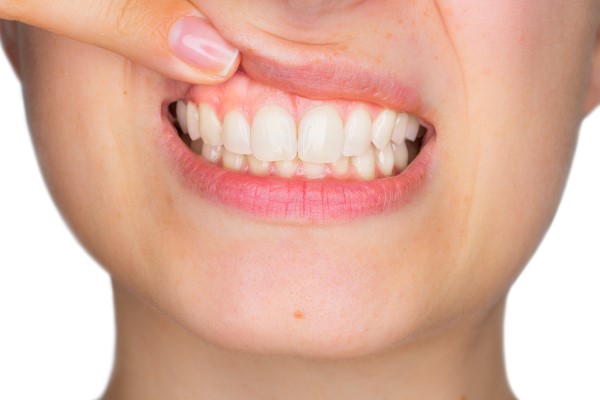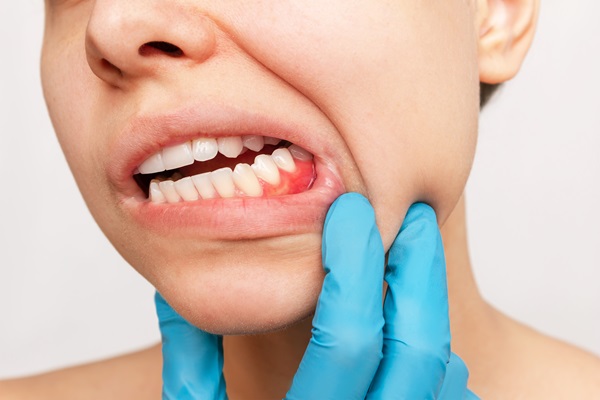Gum Disease Dallas, TX
Solutions for gum disease can help restore your overall oral health. Gum disease is largely preventable. However, if treatment is needed, you will need to see a dental professional.
Solutions for gum disease are available at Lalangas Family Dentistry in Dallas and the surrounding area. Take the first step toward recovery. Call us today at (972) 534-6008 to schedule an appointment and learn more.
Understanding Gum Disease
According to the American Dental Association, gum disease is an infection of the tissues surrounding and supporting the teeth. Gum disease, also known as periodontal disease, is not always accompanied by pain—meaning that patients may not even know that they have it.
Usually, gum disease is caused by a poor oral hygiene routine that allows an excess of plaque (a sticky film of bacteria) to build up on the teeth. When plaque hardens under the gumline into tartar, it becomes more difficult to remove. At this point, the patient will be unable to remove the plaque and tartar without professional dental cleaning.
“Gum disease, also known as periodontal disease or periodontitis, is not always accompanied by pain—meaning that patients may not even know that they have it.”
Preventing Gum Disease
Most cases of gum disease are caused by poor oral hygiene. Unsurprisingly, maintaining a good oral hygiene routine is one of the first lines of defense in protecting oneself against gum disease. Patients should brush their teeth for two minutes at least twice a day and floss at least once a day. Flossing before brushing is imperative, as this allows the patient to clean away any loosened food particles and bacteria. Routine dental visits are also key in preventing gum disease, especially for patients already at risk of developing gum disease. These patients include those who smoke, take certain medications, or suffer from dry mouth. Ideally, patients should have their teeth professionally cleaned every six to 12 months.
“Most cases of gum disease are caused by poor oral hygiene.”
Symptoms of Gum Disease
Gum disease may go unnoticed for some time, especially as it is not always accompanied by pain. Even symptoms in the late stages of gum disease can be very subtle. It is crucial for patients to know the signs of gum disease, so they know how to identify them. Common symptoms of gum disease include but are not limited to:
- Changes in the bite
- Changes in the fit of partial dentures
- Formation of deep pockets between teeth and gums
- Gums that bleed after and during brushing teeth
- Loose or shifting teeth
- Persistent bad breath or taste in the mouth
- Receding gums
- Red, swollen, or tender gums
Patients may still be afflicted by gum disease even without these symptoms. Some people, for instance, may only have gum disease that affects certain teeth. Our team can help identify any dental problems you may have.
“It is crucial for patients to know the signs of gum disease, so they know how to identify them.”
Check out what others are saying about our dental services on Yelp: Gum Disease in Dallas, TX
Treating Gum Disease
The earlier signs of gum disease are detected, the less invasive treatment procedures are. These may include antibiotics, root planing, and scaling. Antibiotics can help control infection and can be administered either topically or orally. Root scaling and planing are often performed together. While root planing smoothes the root surfaces to remove bacteria and discourage further buildup, root scaling removes tartar and bacteria from the tooth surfaces and beneath the gums.
More advanced gum disease may require more invasive solutions, such as oral surgery. Treatments may involve bone grafting, guided tissue regeneration, pocket reduction surgery (also known as flap surgery), soft tissue grafts, and tissue-stimulating proteins. Bone grafting and guided tissue regeneration may help promote bone regeneration. Pocket reduction surgery may allow for more effective root scaling and planing, while soft tissue grafts may reinforce damaged soft tissue. Finally, tissue-stimulating proteins may help stimulate the growth of healthy bone and tissue.
“The earlier signs of gum disease are detected, the less invasive treatment procedures are.”
Questions Answered on This Page
Q. How can I prevent gum disease?
Q. What are the signs of gum disease?
Q. How can I treat gum disease?
People Also Ask
Q. What can I do about receding gums?
Q. What lifestyle factors can trigger gum bleeding?
Q. What are the benefits of getting a gum contouring procedure?
Gum Disease Statistics
According to the Center for Disease Control and Prevention (CDC), almost half of all American adults suffer from some form of periodontal disease. This number increases with age, with 70% of adults 65 years and older reporting to have the condition. Furthermore, it is more common among men than women. To address such problems, the CDC is working with organizations like the American Academy of Periodontology and the American Dental Association to "improve and sustain surveillance of periodontal disease in the adult U.S. population."
“According to the Center for Disease Control and Prevention (CDC), almost half of all American adults suffer from some form of periodontal disease.”
Frequently Asked Questions
Q. What are the risk factors for gum disease?
A. Various risk factors may increase your risk of developing gum disease. These include having gingivitis, poor oral health habits, or inadequate nutrition (particularly a vitamin C deficiency). Smoking or chewing tobacco, as well as recreational drug use, may also increase your risk. Certain genetic conditions, medications, pre-existing health problems, and hormonal changes may also put you at heightened risk.
Q. How is gum disease diagnosed?
A. Your dentist may review your medical history to rule out any other causal factors to your symptoms, then examine your mouth to look for any signs of disease. We will then measure the pocket depth of the groove between your gums and teeth. Then take dental X-rays to check for bone loss in any areas where the dentist notices deeper pocket depths.
Q. Is there a link between gum disease and cardiovascular disease?
A. According to Healthline, recent research shows an association between gum disease and cardiovascular disease. A review of several different studies concluded that gum disease increases a patient's risk of heart disease by approximately 20%. Experts speculate this may be due to inflammation and bacteria in the gums leading to the narrowing of important arteries.
Q. Can children develop gum disease?
A. Gum disease can affect patients of all ages. Children with gum disease usually experience chronic gingivitis, while otherwise healthy young people tend to be afflicted more by aggressive periodontitis. Generalized aggressive periodontitis may also follow puberty due to fluctuating hormone levels.
Q. What is the difference between gingivitis and periodontitis?
A. Gingivitis is a form of gum inflammation that can develop into periodontitis. Our team can work together with patients to help reverse the signs of gingivitis. Periodontitis is another name for gum disease.
Gum Disease Terminology
Learn More Today
Gum disease may lead to worse oral health problems further along the line. We at Lalangas Family Dentistry may be able to help. Call us today at (972) 534-6008 to schedule an appointment and learn more.
Helpful Related Links
- American Dental Association (ADA). Glossary of Dental Clinical Terms. 2023
- American Academy of Cosmetic Dentistry® (AACD). Home Page. 2023
- WebMD. WebMD’s Oral Care Guide. 2023
About our business and website security
- Lalangas Family Dentistry was established in 2023.
- We accept the following payment methods: Cash, Discover, MasterCard, and Visa
- We serve patients from the following counties: Dallas County, Collin County, and Denton County
- We serve patients from the following cities: Dallas, Frisco, McKinney, Garland, Mesquite, Arlington, Plano, University Park, Highland Park and Richardson
- Norton Safe Web. View Details
- Trend Micro Site Safety Center. View Details
Back to top of Gum Disease











